Analysis of the Effects of the River Network Structure and Urbanization on Waterlogging in High-Density Urban Areas—A Case Study of the Pudong New Area in Shanghai
Abstract
1. Introduction
2. Materials and Methods
2.1. Study Area and Data
2.2. River Network Structure
2.3. Impervious Surface Ratio
2.4. Suitable River Network Structure
3. Results and Discussion
3.1. River Network Structure and Urbanization
3.2. Pearson’s Correlation Analysis
3.3. Suitable River Network Structure
4. Conclusions
Author Contributions
Funding
Acknowledgments
Conflicts of Interest
References
- Ebrahimian, A.; Gulliver, J.S.; Wilson, B.N. Effective impervious area for runoff in urban watersheds. Hydrol. Process. 2016, 30, 3717–3729. [Google Scholar] [CrossRef]
- Carpenter, S.R.; Caraco, N.F.; Correll, D.L.; Howarth, R.W.; Sharpley, A.N.; Smith, V.H. Nonpoint pollution of surface waters with phosphorus and nitrogen. Ecol. Appl. 1998, 8, 559–568. [Google Scholar] [CrossRef]
- Olang, L.O.; Furst, J. Effects of land cover change on flood peak discharges and runoff volumes: Model estimates for the nyando river basin, kenya. Hydrol. Process. 2011, 25, 80–89. [Google Scholar] [CrossRef]
- Yao, L.; Chen, L.D.; Wei, W. Exploring the linkage between urban flood risk and spatial patterns in small urbanized catchments of beijing, china. Int. J. Environ. Res. Public Health 2017, 14, 239. [Google Scholar] [CrossRef] [PubMed]
- Zhang, Y.; Xia, J.; Yu, J.; Randall, M.; Zhang, Y.; Zhao, T.; Pan, X.; Zhai, X.; Shao, Q. Simulation and assessment of urbanization impacts on runoff metrics: Insights from landuse changes. J. Hydrol. 2018, 560, 247–258. [Google Scholar] [CrossRef]
- Yao, L.; Wei, W.; Chen, L. How does imperviousness impact the urban rainfall-runoff process under various storm cases? Ecol. Indic. 2016, 60, 893–905. [Google Scholar] [CrossRef]
- Arnold, C.L.; Gibbons, C.J. Impervious surface coverage: The emergence of a key environmental indicator. J. Am. Plann. Assoc. 1996, 62, 243–258. [Google Scholar] [CrossRef]
- Li, C.; Liu, M.; Hu, Y.; Shi, T.; Zong, M.; Walter, M. Assessing the impact of urbanization on direct runoff using improved composite cn method in a large urban area. Int. J. Environ. Res. Public Health 2018, 15, 775. [Google Scholar] [CrossRef]
- Quan, R.S. Rainstorm waterlogging risk assessment in central urban area of shanghai based on multiple scenario simulation. Nat. Hazards 2014, 73, 1569–1585. [Google Scholar] [CrossRef]
- Song, S.; Zeng, L.; Wang, Y.; Li, G.; Deng, X. The response of river network structure to urbanization: A multifractal perspective. J. Clean. Prod. 2019, 221, 377–388. [Google Scholar] [CrossRef]
- Deng, X. Correlations between water quality and the structure and connectivity of the river network in the southern jiangsu plain, eastern china. Sci. Total Environ. 2019, 664, 583–594. [Google Scholar] [CrossRef] [PubMed]
- Sear, D.A.; Newson, M.D. Environmental change in river channels: A neglected element. Towards geomorphological typologies, standards and monitoring. Sci. Total Environ. 2003, 310, 17–23. [Google Scholar] [PubMed]
- Yuan, W.; James, P.; Yang, K. Impact of urbanization on structure and function of river system-case study of shanghai, China. Chin. Geogr. Sci. 2006, 16, 102–108. [Google Scholar] [CrossRef]
- Ji, X.; Xu, Y.; Han, L.; Yang, L. Impacts of urbanization on river system structure: A case study on qinhuai river basin, yangtze river delta. Water Sci. Technol. 2014, 70, 671–677. [Google Scholar] [CrossRef] [PubMed]
- Lin, T.; Liu, X.F.; Song, J.C.; Zhang, G.Q.; Jia, Y.Q.; Tu, Z.Z.; Zheng, Z.H.; Liu, C.L. Urban waterlogging risk assessment based on internet open data: A case study in china. Habitat Int. 2018, 71, 88–96. [Google Scholar] [CrossRef]
- Kim, H.W.; Kim, J.-H.; Li, W.; Yang, P.; Cao, Y. Exploring the impact of green space health on runoff reduction using ndvi. Urban For Urban Gree. 2017, 28, 81–87. [Google Scholar] [CrossRef]
- Zhang, W.; Villarini, G.; Vecchi, G.A.; Smith, J.A. Urbanization exacerbated the rainfall and flooding caused by hurricane harvey in houston. Nature 2018, 563, 384–388. [Google Scholar] [CrossRef] [PubMed]
- Deng, X.; Xu, Y. Degrading flood regulation function of river systems in the urbanization process. Sci. Total Environ. 2018, 622, 1379–1390. [Google Scholar] [CrossRef] [PubMed]
- Liu, C.C.; Shieh, M.C.; Ke, M.S.; Wang, K.H. Flood prevention and emergency response system powered by google earth engine. Remote Sens. 2018, 10, 1283. [Google Scholar] [CrossRef]
- Sin, J.; Jun, C.; Zhu, J.H.; Yoo, C. Evaluation of flood runoff reduction effect of lid (low impact development) based on the decrease in cn: Case studies from gimcheon pyeonghwa district, korea. Procedia Eng. 2014, 70, 1531–1538. [Google Scholar] [CrossRef]
- Li, C.; Liu, M.; Hu, Y.; Shi, T.; Qu, X.; Walter, M.T. Effects of urbanization on direct runoff characteristics in urban functional zones. Sci. Total Environ. 2018, 643, 301–311. [Google Scholar] [CrossRef] [PubMed]
- Quan, R.S.; Liu, M.; Lu, M.; Zhang, L.J.; Wang, J.J.; Xu, S.Y. Waterlogging risk assessment based on land use/cover change: A case study in pudong new area, shanghai. Environ. Earth Sci. 2010, 61, 1113–1121. [Google Scholar] [CrossRef]
- Bulletin of the First National Water Conservancy Census. Available online: http://www.mwr.gov.cn/sj/tjgb/dycqgslpcgb/201701/t20170122_790650.html (accessed on 9 September 2019).
- Rippin, D.M.; Pomfret, A.; King, N. High resolution mapping of supra-glacial drainage pathways reveals link between micro-channel drainage density, surface roughness and surface reflectance. Earth Surf. Proc. Land 2015, 40, 1279–1290. [Google Scholar] [CrossRef]
- Perron, J.T.; Richardson, P.W.; Ferrier, K.L.; Lapôtre, M. The root of branching river networks. Nature 2012, 492, 100. [Google Scholar] [CrossRef] [PubMed]
- Nanson, R.A. Flow fields in tightly curving meander bends of low width-depth ratio. Earth Surf. Proc. Land. 2010, 35, 119–135. [Google Scholar] [CrossRef]
- Milne, B.T.; Gupta, V.K. Horton ratios link self-similarity with maximum entropy of eco-geomorphological properties in stream networks. Entropy 2017, 19, 249. [Google Scholar] [CrossRef]
- Li, C.; Liu, M.; Hu, Y.; Zong, M.; Zhao, M.; Todd Walter, M. Characteristics of impervious surface and its effect on direct runoff: A case study in rapidly urbanized area. Water Supply 2019, 5. [Google Scholar] [CrossRef]
- Ridd, M.K. Exploring a v-i-s (vegetation-impervious-soil) model for urban ecosystem analysis through remote sensing: Comparative anatomy for citiest. Int. J. Remote Sens. 1995, 16, 2165–2185. [Google Scholar] [CrossRef]
- Ministry of Housing and Urban-Rural Development. Technical Guide for Sponge Cities—Water System Construction of Low Impact Development; China Building Industry Press: Beijing, China, 2014; p. 99. [Google Scholar]
- Lin, X.; Ren, J.; Xu, J.; Zheng, T.; Cheng, W.; Qiao, J.; Huang, J.; Li, G. Prediction of life cycle carbon emissions of sponge city projects: A case study in shanghai, china. Sustainability 2018, 10, 3978. [Google Scholar] [CrossRef]
- Shanghai Institute of Water Planning and Design. Shanghai flood control plan (2016-2040). 2015.
- Du, S.; Gu, H.; Wen, J.; Chen, K.; Van Rompaey, A. Detecting flood variations in shanghai over 1949-2009 with mann-kendall tests and a newspaper-based database. Water 2015, 7, 1808–1824. [Google Scholar] [CrossRef]
- Yang, L.; Xu, Y.; Han, L.; Song, S.; Deng, X.; Wang, Y. River networks system changes and its impact on storage and flood control capacity under rapid urbanization. Hydrol. Process. 2016, 30, 2401–2412. [Google Scholar] [CrossRef]
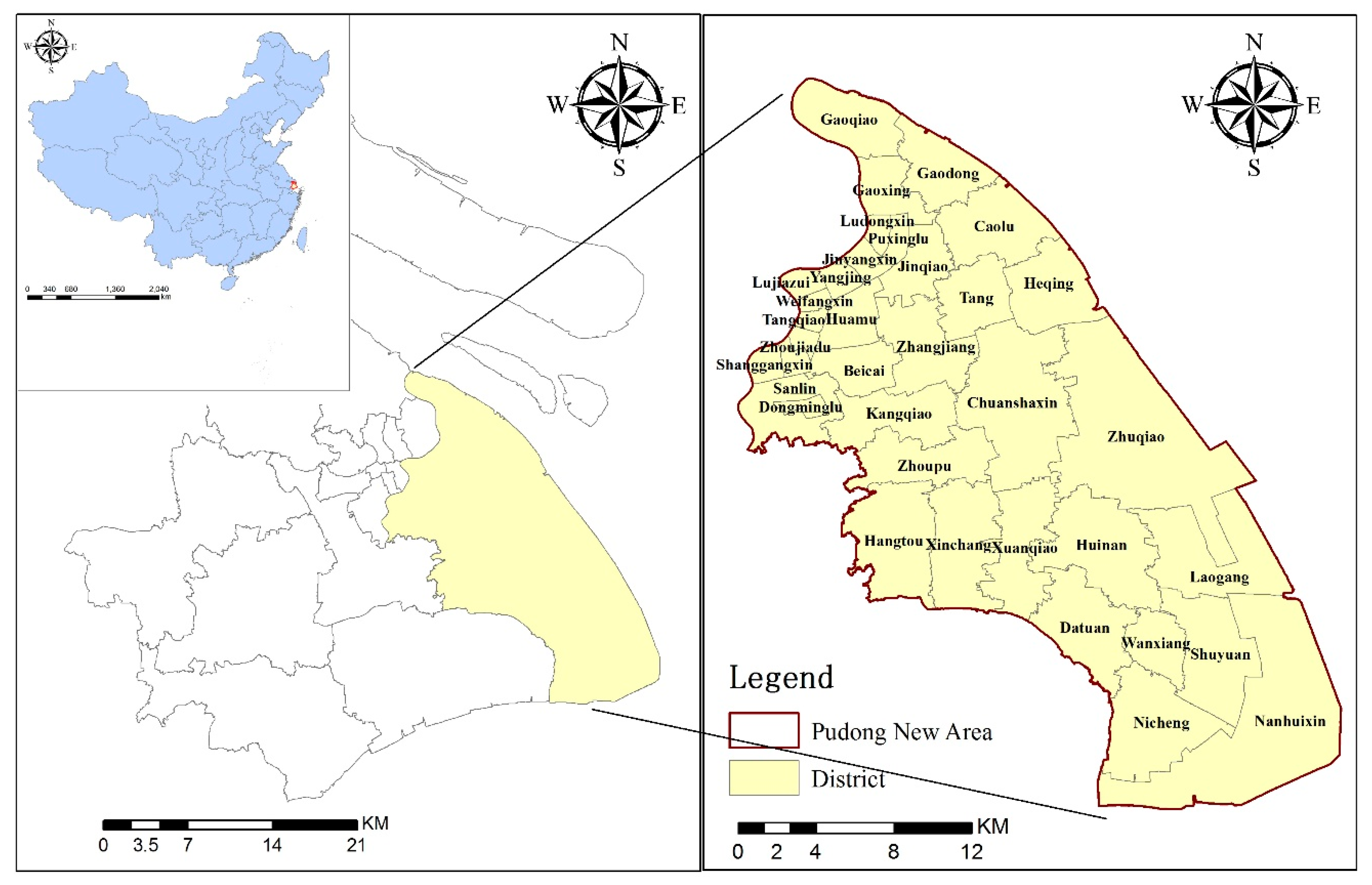
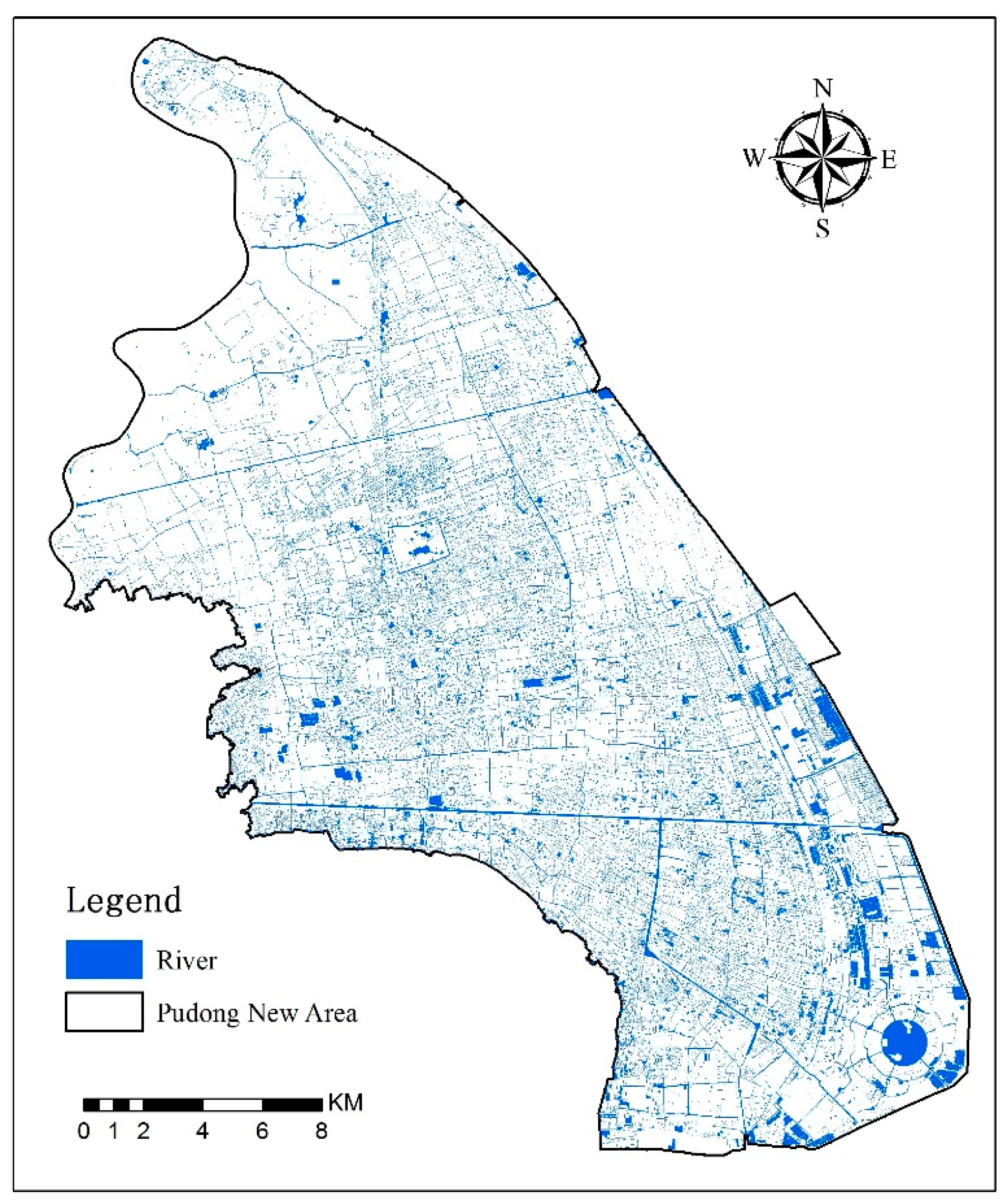
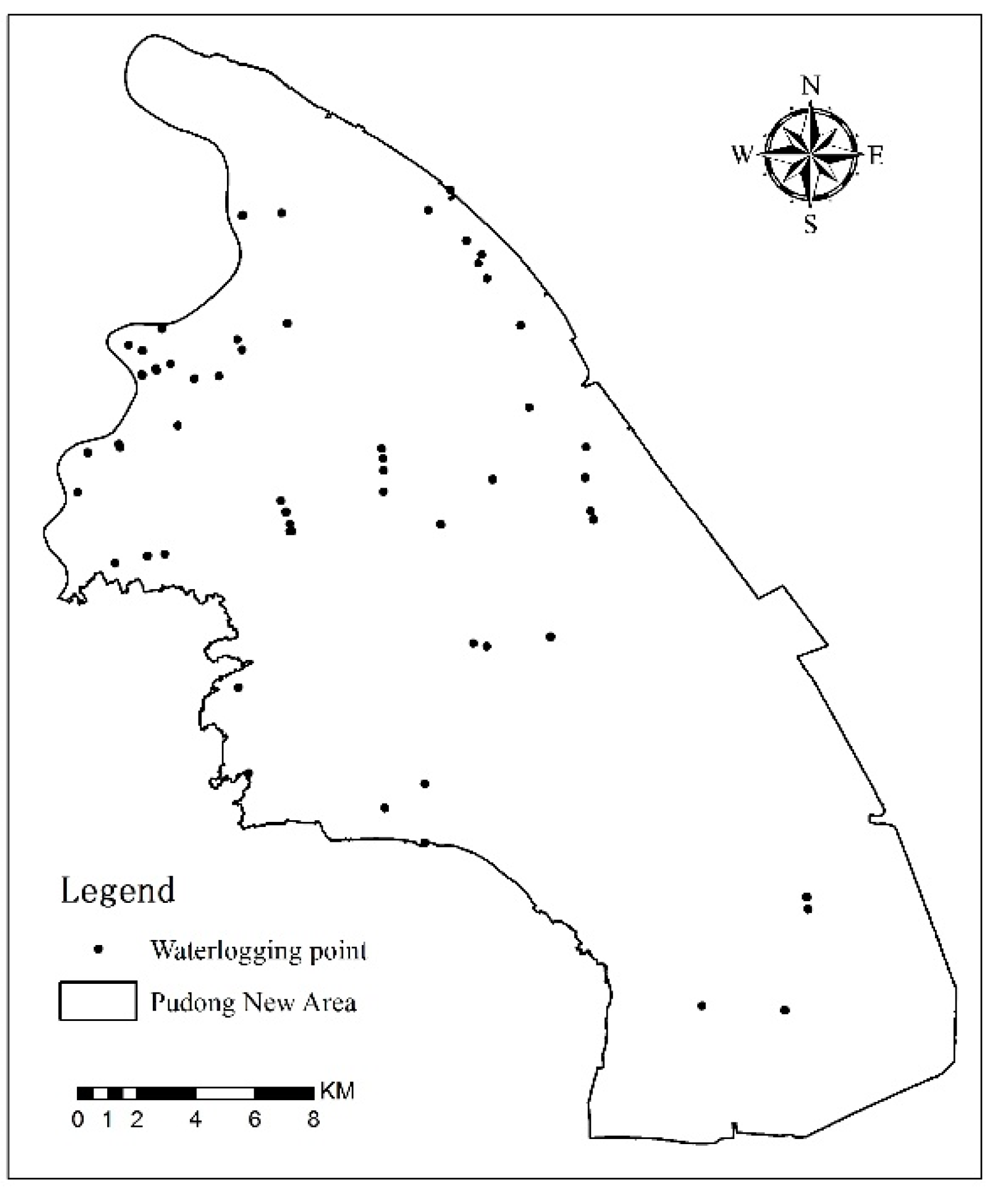
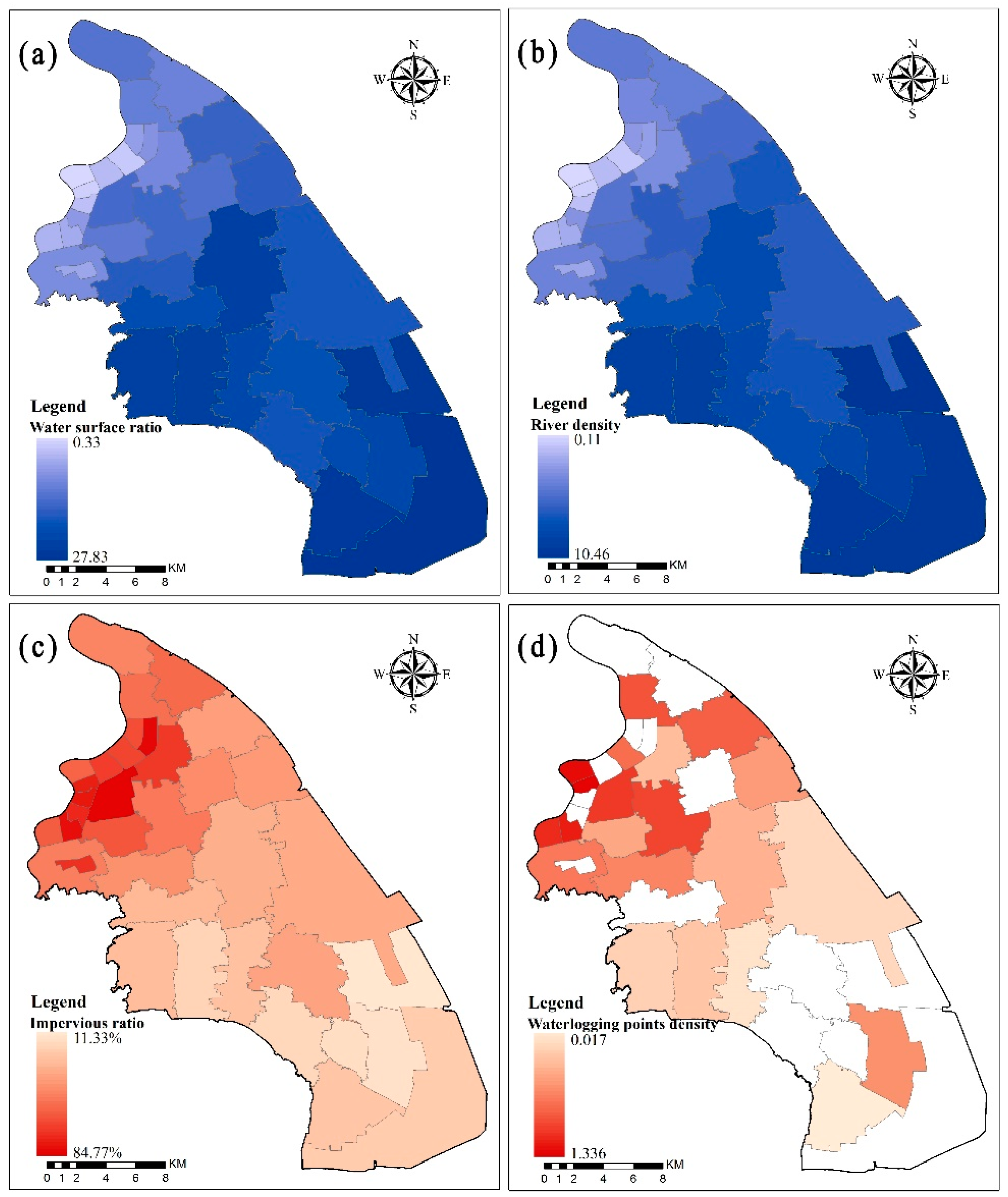

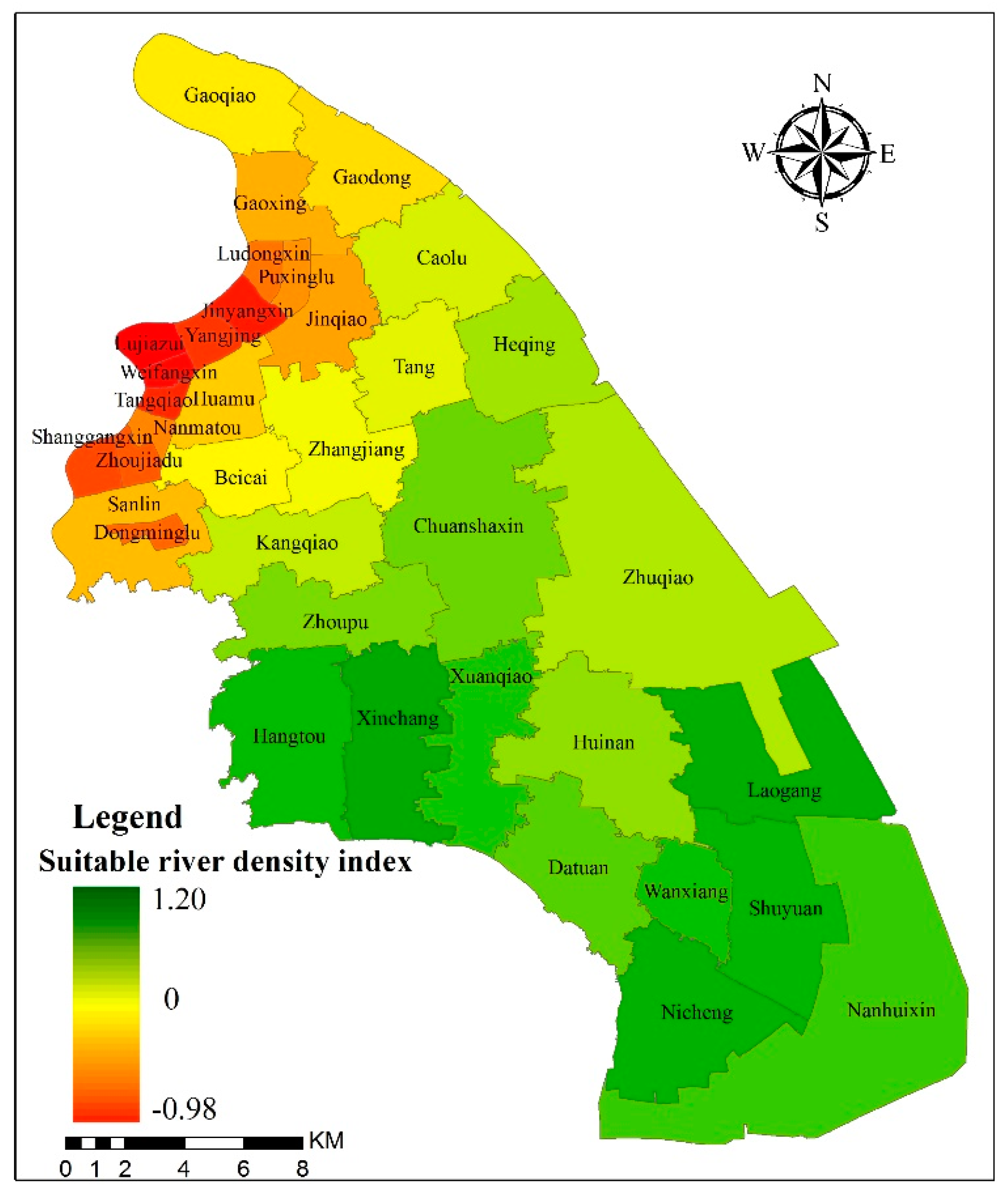
| Variables | Water Surface Ratio (%) | Impervious Ratio (%) | River Density (km/km²) | Waterlogging Points Density (unit/km²) |
|---|---|---|---|---|
| Water Surface Ratio (%) | 1 | −0.881 ** | 0.988 ** | −0.710 ** |
| Impervious Ratio (%) | - | 1 | −0.907 ** | 0.608 ** |
| River Density (km/km²) | - | - | 1 | −0.716 ** |
| Waterlogging Points Density (unit/km²) | - | - | - | 1 |
| Districts | Water Surface Ratio (%) | Suitable Water Surface Ratio (%) | Iwsr | River Density (km/km²) | Suitable River Density (km/km²) | Ird |
|---|---|---|---|---|---|---|
| Beicai | 8.4 | 11.0 | −0.24 | 4.0 | 5.6 | −0.29 |
| Caolu | 11.8 | 9.2 | 0.28 | 4.8 | 4.7 | 0.02 |
| Chuanshaxin | 18.3 | 8.8 | 1.08 | 7.6 | 4.5 | 0.69 |
| Datuan | 15.8 | 8.1 | 0.95 | 7.3 | 4.1 | 0.78 |
| Dongminglu | 3.4 | 11.0 | −0.69 | 1.7 | 5.6 | −0.70 |
| Gaodong | 7.2 | 9.9 | −0.27 | 2.9 | 5.0 | −0.42 |
| Gaoxing | 8.3 | 10.2 | −0.19 | 2.7 | 5.2 | −0.48 |
| Gaoqiao | 8.5 | 10.1 | −0.16 | 3.1 | 5.2 | −0.40 |
| Hangtou | 20.9 | 8.4 | 1.49 | 8.6 | 4.3 | 1.00 |
| Heqing | 12.6 | 9.4 | 0.34 | 5.6 | 4.8 | 0.17 |
| Hudongxin | 3.8 | 11.6 | −0.67 | 1.9 | 5.9 | −0.68 |
| Huamu | 11.1 | 11.5 | −0.03 | 3.4 | 5.9 | −0.42 |
| Huinan | 16.0 | 8.9 | 0.80 | 6.6 | 4.6 | 0.43 |
| Jinqiao | 6.5 | 10.8 | −0.40 | 2.6 | 5.5 | −0.53 |
| Jinyangxin | 1.4 | 11.7 | -0.88 | 0.7 | 6.0 | −0.88 |
| Kangqiao | 12.8 | 9.0 | 0.42 | 4.8 | 4.6 | 0.04 |
| Laogang | 24.0 | 9.9 | 1.42 | 10.5 | 5.0 | 1.10 |
| Lujiazui | 0.3 | 11.7 | −0.97 | 0.1 | 6.0 | −0.98 |
| Nanhuixin | 27.8 | 10.8 | 1.57 | 10.0 | 5.5 | 0.82 |
| Nanmatou | 3.8 | 11.6 | −0.67 | 1.9 | 5.9 | −0.68 |
| Nicheng | 21.4 | 8.4 | 1.55 | 9.0 | 4.3 | 1.09 |
| Puxinglu | 4.1 | 11.4 | −0.64 | 1.9 | 5.8 | −0.67 |
| Sanlin | 6.2 | 10.1 | −0.39 | 2.8 | 5.1 | −0.45 |
| Shanggangxin | 2.4 | 11.2 | −0.79 | 1.0 | 5.7 | −0.82 |
| Luyuan | 18.2 | 8.1 | 1.25 | 8.4 | 4.1 | 1.05 |
| Tang | 11.1 | 9.3 | 0.19 | 4.8 | 4.7 | 0.02 |
| Tangqiao | 1.4 | 11.6 | −0.88 | 0.7 | 5.9 | −0.88 |
| Wanxiang | 17.7 | 8.2 | 1.16 | 8.1 | 4.2 | 0.93 |
| Weifangxin | 1.2 | 11.6 | −0.90 | 0.6 | 5.9 | −0.90 |
| Xinchang | 20.9 | 8.1 | 1.58 | 9.0 | 4.1 | 1.20 |
| Xuanqiao | 18.0 | 8.4 | 1.14 | 8.1 | 4.3 | 0.88 |
| Yangjing | 1.9 | 11.6 | −0.84 | 1.0 | 5.9 | −0.83 |
| Zhangjiang | 11.7 | 10.3 | 0.14 | 5.1 | 5.2 | −0.02 |
| Zhoujiadu | 3.0 | 11.4 | −0.74 | 1.6 | 5.8 | −0.72 |
| Zhoupu | 17.5 | 8.3 | 1.11 | 6.9 | 4.3 | 0.60 |
| Zhuqiao | 12.9 | 9.3 | 0.39 | 5.4 | 4.7 | 0.15 |
| Pudong New Area | 10.9 | 10.0 | 0.09 | 4.6 | 5.1 | −0.10 |
© 2019 by the authors. Licensee MDPI, Basel, Switzerland. This article is an open access article distributed under the terms and conditions of the Creative Commons Attribution (CC BY) license (http://creativecommons.org/licenses/by/4.0/).
Share and Cite
Liu, S.; Lin, M.; Li, C. Analysis of the Effects of the River Network Structure and Urbanization on Waterlogging in High-Density Urban Areas—A Case Study of the Pudong New Area in Shanghai. Int. J. Environ. Res. Public Health 2019, 16, 3306. https://doi.org/10.3390/ijerph16183306
Liu S, Lin M, Li C. Analysis of the Effects of the River Network Structure and Urbanization on Waterlogging in High-Density Urban Areas—A Case Study of the Pudong New Area in Shanghai. International Journal of Environmental Research and Public Health. 2019; 16(18):3306. https://doi.org/10.3390/ijerph16183306
Chicago/Turabian StyleLiu, Song, Mengnan Lin, and Chunlin Li. 2019. "Analysis of the Effects of the River Network Structure and Urbanization on Waterlogging in High-Density Urban Areas—A Case Study of the Pudong New Area in Shanghai" International Journal of Environmental Research and Public Health 16, no. 18: 3306. https://doi.org/10.3390/ijerph16183306
APA StyleLiu, S., Lin, M., & Li, C. (2019). Analysis of the Effects of the River Network Structure and Urbanization on Waterlogging in High-Density Urban Areas—A Case Study of the Pudong New Area in Shanghai. International Journal of Environmental Research and Public Health, 16(18), 3306. https://doi.org/10.3390/ijerph16183306






